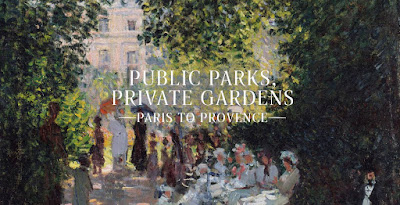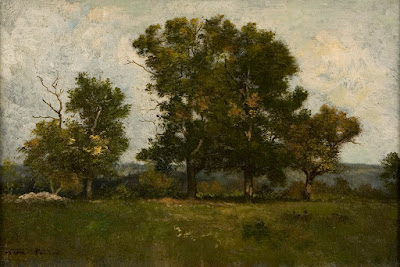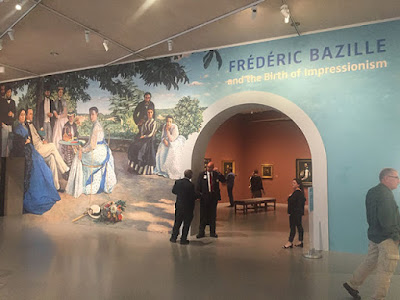
"Following in the footsteps of nineteenth-century artists who celebrated the out-of-doors as a place of leisure, renewal, and inspiration, this exhibition explores horticultural developments that reshaped the landscape of France and grounded innovative movements—artistic and green—in an era that gave rise to Naturalism, Impressionism, and Art Nouveau. As shiploads of exotic botanical specimens arrived from abroad and local nurserymen pursued hybridization, the availability and variety of plants and flowers grew exponentially, as did the interest in them. The opening up of formerly royal properties and the transformation of Paris during the Second Empire into a city of tree-lined boulevards and parks introduced public green spaces to be enjoyed as open-air salons, while suburbanites and country-house dwellers were prompted to cultivate their own flower gardens. ... The important role of parks and gardens in French life during this period is richly illustrated by paintings, drawings, photographs, prints, illustrated books, and objects in The Met collection by artists extending from Camille Corot to Henri Matisse, many of whom were gardeners themselves. ..."
Metropolitan Museum of Art
Metropolitan Museum of Art: Exhibition Galleries
Metropolitan Museum of Art: Related Videos (Video)
Habitually Chic
Metropolitan Museum of Art: Public Parks, Private Gardens: Paris to Provence
 Impressionism
Impressionism
 Claude Monet, Impression, soleil levant, 1872
Claude Monet, Impression, soleil levant, 1872
"
Impressionism is a 19th-century
art movement characterized by relatively small, thin, yet visible brush strokes, open
composition, emphasis on accurate depiction of light in its changing qualities (often accentuating the effects of the passage of time), ordinary subject matter, inclusion of
movement as a crucial element of human perception and experience, and unusual visual angles. Impressionism originated with a group of Paris-based artists whose independent exhibitions brought them to prominence during the 1870s and 1880s. The Impressionists faced harsh opposition from the conventional art community in
France. The name of the style derives from the title of a
Claude Monet work,
Impression, soleil levant (
Impression, Sunrise), which provoked the critic
Louis Leroy to coin the term in a satirical review published in the Parisian newspaper
Le Charivari. The development of Impressionism in the
visual arts was soon followed by analogous styles in other media that became known as
impressionist music and
impressionist literature. ..."
Wikipedia
 Luncheon at the Boating Lake, Renoir, 1880-1
The Barbizon School: French Painters of Nature
Luncheon at the Boating Lake, Renoir, 1880-1
The Barbizon School: French Painters of Nature
 Léon Richet, Les Arbres à Barbizon
Léon Richet, Les Arbres à Barbizon
"In early nineteenth-century France, landscape painting was narrowly circumscribed by an aesthetic code upheld by the conservative
French Academy. Painters and sculptors were rigorously trained in the
Neoclassical tradition to emulate artists of the Renaissance and classical antiquity. In the hierarchy of historical subjects recognized by the Academy, pure
landscape painting was not a privilege. At best, artists could hope to paint an idealized nature inspired by ancient poetry. The grand classicizing subjects of the seventeenth-century painters
Nicolas Poussin and Claude Lorrain presented other acceptable models."
The Metropolitan Museum of Art
W - Barbizon school
Barbizon School of Landscape Painting
YouTube: Barbizon: The Cradle of Impressionism
 Charles-Francois Daubigny, Cottages at Barbizon: Evening 1817 - 1878
Les Nabis
Charles-Francois Daubigny, Cottages at Barbizon: Evening 1817 - 1878
Les Nabis
 Maurice Denis, September Evening (Women Sitting on the Terrace), 1891
Maurice Denis, September Evening (Women Sitting on the Terrace), 1891
"
Les Nabis (
French pronunciation: [le nabi]) was a group of young French artists active in Paris from 1888 until 1900, who played a large part in the transition from
impressionism and academic art to
abstract art,
symbolism and the other early movements of
modernism. The members included
Pierre Bonnard,
Maurice Denis,
Paul Ranson,
Édouard Vuillard,
Ker-Xavier Roussel,
Félix Vallotton, and
Paul Sérusier. Most were students at the
Académie Julian in
Paris in the late 1880s. The artists shared a common admiration for
Paul Gauguin and
Paul Cézanne and a determination to renew the art of painting, but varied greatly in their individual styles. They believed that a work of art was not a depiction of nature, but a synthesis of metaphors and symbols created by the artist. In 1900, the artists held their final exhibit, and went their separate ways. ..."
Wikipedia
The Radiant Paintings of Les Nabis, the Movement Started by Bonnard and Vuillard
Metropolitan Museum of Art: The Nabis and Decorative Painting
The Nabis 101
Musée d'Orsay: Nabis and decoration. Bonnard, Vuillard, Maurice Denis... (Video)
YouTube: les nabis 26 videos
 Les Nabis at Stephane Natanson’s house in Villeneuve-sur-Yonne, south-east of Paris, c. 1898. Lying, from left: Felix Valloton, Édouard Vuillard, Stephane Natanson, Marthe Mellot, Thadée Natanson and Misia Natanson. Standing: Cipa (half-brother of Misia Natanson).
Impressionism, Fashion, and Modernity
Les Nabis at Stephane Natanson’s house in Villeneuve-sur-Yonne, south-east of Paris, c. 1898. Lying, from left: Felix Valloton, Édouard Vuillard, Stephane Natanson, Marthe Mellot, Thadée Natanson and Misia Natanson. Standing: Cipa (half-brother of Misia Natanson).
Impressionism, Fashion, and Modernity
 Left. Albert Bartholomé. In the Conservatory, c. 1881. Musée d’Orsay, Paris. Right. Summer dress worn by Madame Bartholomé in the painting In the Conservatory, French, 1880. Musée d’Orsay, Paris.
Left. Albert Bartholomé. In the Conservatory, c. 1881. Musée d’Orsay, Paris. Right. Summer dress worn by Madame Bartholomé in the painting In the Conservatory, French, 1880. Musée d’Orsay, Paris.
"
Impressionism, Fashion, and Modernity presents a revealing look at the role of fashion in the works of the Impressionists and their contemporaries. Some eighty major figure paintings, seen in concert with period costumes, accessories, fashion plates, photographs, and popular prints, highlight the vital relationship between fashion and art during the pivotal years, from the mid-1860s to the mid-1880s, when Paris emerged as the style capital of the world. With the rise of the department store, the advent of ready-made wear, and the proliferation of fashion magazines, those at the forefront of the avant-garde — from Manet, Monet, and Renoir to Baudelaire, Mallarmé, and Zola — turned a fresh eye to contemporary dress, embracing
la mode as the harbinger of
la modernité."
Metropolitan Museum
amazon: Impressionism, Fashion, and Modernity
NYT: The Cross-Dressing of Art and Couture
NYT: The Fashion Show From the Belle Époque
YouTube: The Metropolitan Museum of Art: Impressionism, Fashion and Modernity
Frédéric Bazille and the Birth of Impressionism

"A scion of a Protestant upper-middle-class family from Montpellier in southern France, Frédéric Bazille (1841–1870) seemed destined for a career in medicine. In 1862 he traveled to Paris, ostensibly to pursue his medical studies, though he also enrolled as a student in the studio of the painter Charles Gleyre. It was there that he met fellow artists Claude Monet, Auguste Renoir, and Alfred Sisley, even sharing studio space with both Monet and Renoir at times. He soon became part of a dynamic circle of avant-garde artists and writers that included Édouard Manet, Henri Fantin-Latour, Émile Zola, and Zacharie Astruc. Like his friends, Bazille created paintings inspired by contemporary life that challenged the aesthetic conventions of the day and helped to lay the groundwork of impressionism. Unfortunately, Bazille was killed in battle during the Franco-Prussian War, just prior to his 29th birthday, bringing his promising career to an abrupt and tragic end. ..."
NGA
NGA (Audio)
Chong reviews Frederic Bazille and the Birth of Impressionism
amazon

















































